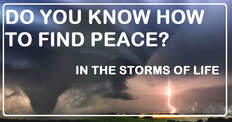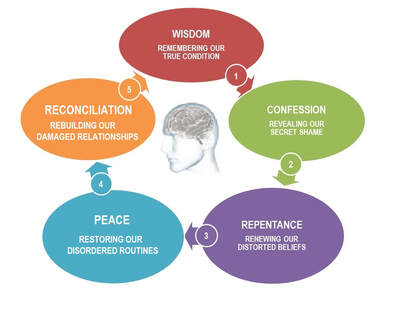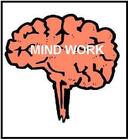
Growing up in a parsonage as I did, I saw my pastor-father go through lots of good times and bad in the ministry. I recall one particular rough storm when I was about 14 years old and it stands out because I remember especially the look of fear and weariness in his face. Even though I didn't know what was going on, I knew something was wrong. I felt a bit bad for him, but not knowing the details of his pain, it left me more confused and curious than anything. Oh, and distant. Let's not forget that.
I recall looking into his eyes one day and saying hello only to be greeted mechanically and dispassionately as if he didn't even recognize me. Fourteen year old boys don't understand things like that, and instead of concern for his mental health I only felt like he didn't love me anymore.
We got through the worst of that storm, but not without some lingering scars. That's all history and even though I am sure God used it to sensitize me and predispose me to the life of clergy care I chose years later, I still wonder about the particular storms he endured that I never did hear about. He's in heaven now, so I will never know. But my research of clergy care over 40 years has caused me to conclude there are five broad storms that ministers endure. I've devoted my own ministry to helping ministers like my dad find peace in them.
Burnout - Storms of Ministry Imagination
Secrecy - Storms of Ministry Internalization
Doubt - Storms of Ministry Idealization
Bad Habits - Storms of Ministry Impoverization
Relational Conflicts - Storms of Ministry Isolation
We all go through these storms, sometimes repeatedly. The details are different for everyone. But the general outlines are the same. I write about them in all my clergy resources and share my own personal as well as biblical and scientific research.
In the middle of the storms it's easy to despair. I sometimes talk about the neural circuits of despair--the helpless, hopeless, hapless circuits in the triune brain. I saw them and their effects in my dad. I've seen them in myself and others. Tragically, I've seen some ministers never recover from them.
Yet, as a Christian counselor, I do not believe that was God's plan for the storms. Ministry storms, like the perfect storm on the Sea of Galilee, were always a means to a greater end! God's plan for the storms is to transform us and make us the ministers he wants us to be. The pounding waves and shrieking winds of trauma are necessary to get our attention and show us our fears. We don't like them one bit and desperately want it just to be over!
But, if we only had eyes to see, Jesus is right close by. It appears he is asleep in the stern of our "boat." And because of that we sometimes shout at him, like Peter in the storm on Galilee: "Don't you care that I'm drowning?" I've done that. So have all ministers.
And it is then, perhaps more than at any moment in the five storms, that we are ready to learn the steps to peace. For that's what it's all about. The storms are only the means to a glorious end!
Transforming the Storms
God wants to transform us and use the very storm to do it.
Transforming Ministry Imaginations through Biblical Wisdom
Transforming Ministry Internalization through Biblical Confession
Transforming Ministry Idealization through Biblical Repentance
Transforming Ministry Impoverization through Biblical Shabbat Shalom
Transforming Ministry Isolation through Biblical Reconciliation
I recall looking into his eyes one day and saying hello only to be greeted mechanically and dispassionately as if he didn't even recognize me. Fourteen year old boys don't understand things like that, and instead of concern for his mental health I only felt like he didn't love me anymore.
We got through the worst of that storm, but not without some lingering scars. That's all history and even though I am sure God used it to sensitize me and predispose me to the life of clergy care I chose years later, I still wonder about the particular storms he endured that I never did hear about. He's in heaven now, so I will never know. But my research of clergy care over 40 years has caused me to conclude there are five broad storms that ministers endure. I've devoted my own ministry to helping ministers like my dad find peace in them.
Burnout - Storms of Ministry Imagination
Secrecy - Storms of Ministry Internalization
Doubt - Storms of Ministry Idealization
Bad Habits - Storms of Ministry Impoverization
Relational Conflicts - Storms of Ministry Isolation
We all go through these storms, sometimes repeatedly. The details are different for everyone. But the general outlines are the same. I write about them in all my clergy resources and share my own personal as well as biblical and scientific research.
In the middle of the storms it's easy to despair. I sometimes talk about the neural circuits of despair--the helpless, hopeless, hapless circuits in the triune brain. I saw them and their effects in my dad. I've seen them in myself and others. Tragically, I've seen some ministers never recover from them.
Yet, as a Christian counselor, I do not believe that was God's plan for the storms. Ministry storms, like the perfect storm on the Sea of Galilee, were always a means to a greater end! God's plan for the storms is to transform us and make us the ministers he wants us to be. The pounding waves and shrieking winds of trauma are necessary to get our attention and show us our fears. We don't like them one bit and desperately want it just to be over!
But, if we only had eyes to see, Jesus is right close by. It appears he is asleep in the stern of our "boat." And because of that we sometimes shout at him, like Peter in the storm on Galilee: "Don't you care that I'm drowning?" I've done that. So have all ministers.
And it is then, perhaps more than at any moment in the five storms, that we are ready to learn the steps to peace. For that's what it's all about. The storms are only the means to a glorious end!
Transforming the Storms
God wants to transform us and use the very storm to do it.
Transforming Ministry Imaginations through Biblical Wisdom
Transforming Ministry Internalization through Biblical Confession
Transforming Ministry Idealization through Biblical Repentance
Transforming Ministry Impoverization through Biblical Shabbat Shalom
Transforming Ministry Isolation through Biblical Reconciliation



 RSS Feed
RSS Feed
